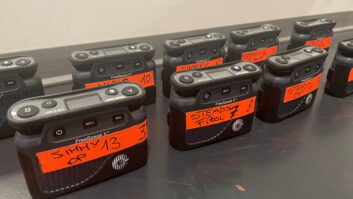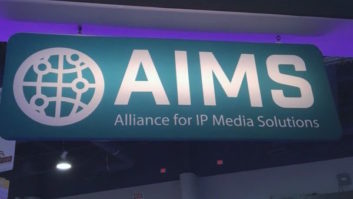For a simpler, cheaper and less disruptive installation, running audio over existing networks and cabling makes sense. However, IP-based systems currently have some hurdles to overcome, both technologically and in terms of their perception in the market.
While the R&D challenges of getting products to work are within the control of audio manufacturers, the challenge of changing a client’s perception and business structure can take more diplomacy. If a huge multinational corporation is looking to install or refurbish, then budgets must be juggled and combined in order to maximise the cost-efficiency of combining various audio communication systems and running them over IP in a network-centric construct.
There is plenty of opportunity to demonstrate these new IP audio systems in Europe’s healthy market. European audio companies are installing at home and pursuing the hot and growing markets of eastern Europe and the Middle East. Paging and intercom systems are two different animals, but their IP lines follow similar audio tech paths. Running paging and intercoms over IP lines can be paralleled to a few other IP technologies in recent history, such as voice over IP and IP-based video surveillance cameras. Jake Dodson, Clear-Com’s UKbased vice president of product management, relates the perception of IP solutions in this industry to what the telecoms industry went through. “Voice over IP had a bad rap,” he says. “The technology first brought to market wasn’t up to standard.”
Johannes G Rietschel, chief executive and founder of Zurichbased Barix, compares audio intercoms and paging to their video counterpart. “IP-based video surveillance systems have only 20- 30% market share, but it’s rapidly growing,” he says. “People figure out it’s not more expensive and they get all the benefits of using traditional infrastructure. We ride on this wave.”
While IP is the way of the future, it’s not right for all applications at this time. For communications between different cities, IP is the cost-effective solution. Andreas Hilmer, responsible for marketing and communications at Riedel, believes that since IP usually has some delays, “an IPbased system would not be chosen to execute a theatrical show, for example, where it is all about realtime communications.”
However, he adds: “IP in general will definitely improve and become more and more important. What people expect from it is a reduction in price.”
Dodson believes in a hybrid world for intercom systems. New technologies from Clear-Com feature a hybrid of IP-based technology and classic time domain multiplexing (TDM). “We’ve had products on the market for two and a half years now on the IP side,” says Dodson. “Clear-Com is offering new ways of communicating based on a proven communications infrastructure with TDM matrixes that have IP connections for remote users.” Clear-Com has just launched a communications product called Concert that works entirely on an IT network-based infrastructure.
Instead of having a comms hardware panel at a desk, a Concert client runs on a PC or laptop that goes back to a central IT server. “In the future we see that kind of environment linking across into the standard TDM comms,” says Dodson. “I would not suggest an all-IP world for many years. There are lots of infrastructure investments still to be made globally. IP is on a definite upward trajectory, but doing it well is a whole different game.”
Nico Lewis, sales manager Western Europe for critical communications systems (CCS) at Telex, handles intercom work mainly for broadcast applications. “We see a lot of growth at the moment in global communication,” he says. “We developed an IP-based communication interface called RVON (RTS Voice over Network). Within this IP-based system, we can connect the world with each other. When we started, everyone was sceptical. Now broadcast trucks communicate with transmission towers over IP to be flexible so that regional studio centres can communicate over IP to save telephone costs.”
CCS Telex/RTS uses intelligent trunking to connect different islands to each other. “In this way our customers can build a system with up to 31 different matrices of any type,” says Lewis. “Every single matrix of that system can be an 8×8 matrix up to a 1,000×1,000 port matrix system.” For permanent installations, Barix products have been used for intercoms at the Euro 2008 football championships, but sports venues are not a major focus for the company at this point. “In a stadium you need low latency systems for intercom,” says Rietschel. “At least in people’s minds, that is not IP, it’s CobraNet or Ethersound. This perception is changing.”
Rietschel believes that more people are understanding that IP can also deliver low latency. For many applications, IP is suitable and much easier to use than proprietary systems such as CobraNet. “Five years ago everyone thought it would be impossible to run life safety/evacuation systems over IP,” he says. “For over a year there has been a system on the market from one of our OEMs that is a full life safety evacuation system based on our IP technology. It is being used where people traditionally used other systems in order to achieve redundancy.”
Eric Bevillard is product manager for PYKO at Digigram, a company that offers a ‘computer/ network audio’ approach for its communications systems. Eight years ago, Digigram proposed a disruptive approach with the Audio Manager software controlling NCX devices, which were using Ethernet streaming. But there were some remaining important limitations that pushed Digigram to develop a new generation over IP: the PYKO, with heavily redesigned Audio Manager software. PYKO is designed for long distances since it is flexible thanks to the IP, and is often a cheap solution because the network is already installed.
The good market
Many in the industry are surprised that the market in Europe is as strong as it is. The year started with talk of gloom and doom and recession. But market and technological factors have trumped that attitude with the focus on high definition for the past three or four years. A lot of HD installations have been either budgeted for or completed. With the new equipment required for HD, it’s not a big jump to realise new intercoms are necessary.
In the broadcast market, the Middle East is growing rapidly – having doubled turnover in the past couple of months. Eastern Europe, especially Bulgaria and Poland, is also doing well due to big investments this year and last year as conversions to fully high def were undertaken. “New markets are up and coming, such as Ukraine and Serbia,” says Telex’s Lewis. “The Russian market is doing well prepar- ing for the 2014 Winter Olympics. That’s a big market for us.”
ic audio is seeing solid growth in Germany and other European markets. However, Sascha Riedling, sales and marketing director at the PA manufacturer, says “it’s nothing compared to the fast-growing markets in the Middle East and in Asia”. He adds: “In Europe, the fastest growing markets are in eastern Europe: Poland, Romania and, for the future, Bulgaria are the key countries for massive growth.”
Convincing the client
In order for the market to remain strong, a key factor will be convincing a client with a variety of factions to accept this new concept of IP and reallocate their budgets to work together, as opposed to having a separate budget for different audio systems. “The corporate and enterprise sector is growing, but not in a classic way,” says Clear-Com’s Dodson. “There are more situations where what IP provides overlaps nicely with the communications needs in a modern international business: good quality audio, multiple people in remote locations, IT-centric infrastructures. For our new IP technologies, there are a lot of synergies in those markets.”
Clear-Com sees its role as introducing the highest-quality audio communication technologies within global companies. “The key to the value we offer is not just a variety of technologies but linking various technologies together in a unified manner.
Then customers can start driving through efficiencies in their businesses and drive down costs,” says Dodson. Similarly, there is some convincing to do in the paging world. Graeme Harrison, vice president, international sales at Biamp, says that for his company, the future is a facility-wide system.
For a recent project at a campuswide military installation, Biamp was presented with two separate liaisons: one person for conference rooms and videoconferencing, and another in charge of the paging system. “They wanted to link via fibre a number of buildings on the campus,” says Harrison. “Half an hour into the meeting, I said: ‘You do realise this could be one system!’” The idea of buying just one system with one point of control, one network that did everything, turned out to be very appealing.
Achieving unity
Biamp has realised that complications may come from a client that has different budgets from different departments. Similarly, in a sports stadium, the paging system is also the sound system in the corporate boxes and the meeting room system and the boardroom system. “But the client has different budgets for each,” says Harrison. “The different departments need to talk to each other and to agree on a unified approach. It’s a trend people will take a while to get used to. But it’s what’s going to happen. It makes no sense to have separate systems; just like it makes no sense to have one computer to do spreadsheets and another to do word processing.”
Heightened security requirements in stadiums and other public places are driving the market for paging systems. EN6849 and its derivatives, which are becoming more widely adopted in Europe, require that public spaces with more than 100 people have life safety, evacuation and paging systems. “That’s meant the life safety/evacuation/paging market is increasing in Europe,” says Biamp’s Harrison.
Biamp’s equipment is all TCP-IP addressable and sits on a network. “We’re able to run both audio and control over existing networks and cabling,” adds Harrison. The company has extended that concept to its paging microphones. Biamp introduced a network paging station last autumn called NPS1, which communicates with the rest of the system with one Cat-5 cable that carries power over Ethernet, along with data and audio.
Needs vary
A variety of systems can be formulated to suit customer requirements. There is a continuum from a highquality loudspeaker entertainment system that does some paging in a sports centre, through to a voice system in rapid transit applications.
A sports venue is very output intensive. “They might have only one or two paging mics but they might have 50 or 100 different zones,” says Biamp’s Harrison. “An airport would have a lot of microphones – one for each gate – and probably a similar number of outputs as the sports venue.”
Defining priorities is crucial in a system with a lot of microphones. “The more complex the inputs, the more flexible your system has to be in terms of how you police and arbitrate for the different people in the systems who want to do different things at the same time,” says Harrison. An airport would be more functionality- driven than a sports arena, for example, because it is more complex in terms of priorities for paging. An airport system may use store and forward functionality, where the page is held until all the output zones are available for use.
Something new for airports recently is the importance of archiving. “If something goes wrong, they can listen to pages and make sure everyone did what they were supposed to do in terms of evacuating people,” says Harrison. Needs also vary according to the size of the project; in many small projects, basic paging solutions without surveillance are requested. “In this case the product should be very price competitive and easy to handle,” says ic audio’s Riedling.
In mid-sized installations, surveillance and ‘zone power’ are the key topics. Riedling observes that customers want a product that is small to save rack space (and cost), along with the opportunity to add up to maybe 80 speaker zones. For large projects, for example in airports, the main concern is to have a fully integrated network solution. The systems have to communicate with other installed systems. Furthermore the highest security levels have to be reached. “So for the big one, it’s maximum life safety combined with a fully integrated network-based solution,” says Riedling. With the consolidation of companies in many industries, the need for intercom and paging communications between a multitude of sites and venues will become more important. IP technology, the common denominator for communication and data transfer, is improving and becoming seamless for the user. Just as data and matrices are becoming united, progress is also being made on the business side to unite the budgets required to pay for this technology







